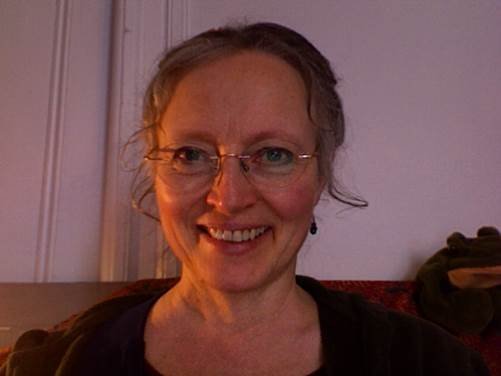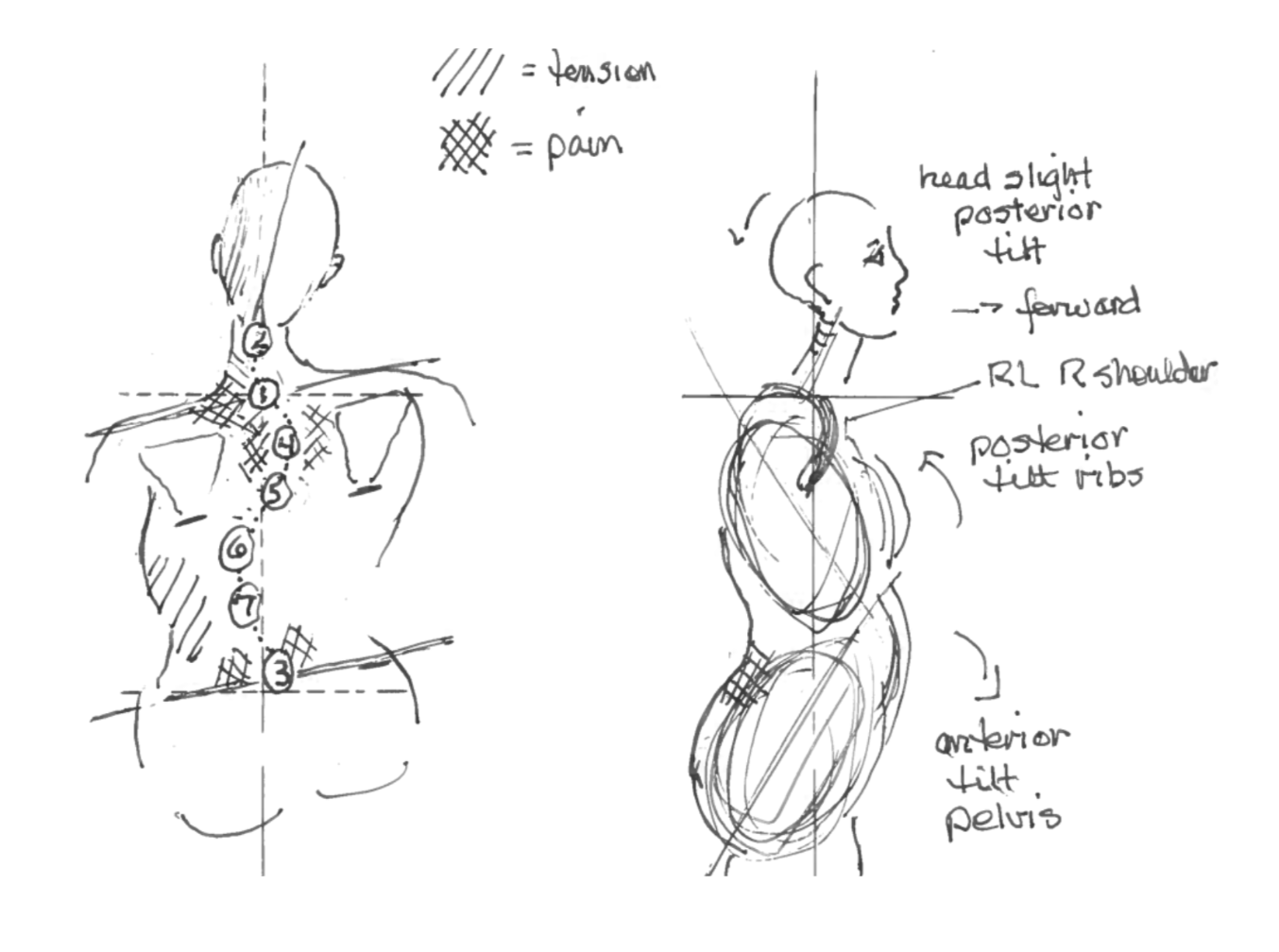Somatic Strategies for Asymmetrical Patterns and Scoliosis
By Laura M Gates, CHSE, CCSE, Trainer at Essential Somatics, LLC
Beginnings
My journey with this work began around 2003, living in upstate NY, when a friend handed me Tom Hanna’s book Somatics: Reawakening the Mind’s Control of Movement, Flexibility, and Health and I resonated with what I read. That led me to have some sessions with Dave MacDougall, a student from Hanna’s Wave 1 class. The clear and surprising results of the hands-on techniques turned a light on in my brain and my soul, and I knew then that I would someday be a practitioner and teacher of this work. It took a few more years and a major life shift to allow me to begin my training at Somatic Systems Institute (SSI), graduating in 2007 with certification by SSI and The Novato Institute. I moved back to New York City and begin building a practice and teaching classes.
It was tough going in those early years, and I also did other jobs to support myself, since hardly anyone knew about this work, even in New York. But I was determined to move it forward and get it out there. And my passion continues, as I know it does for you! Later I joined Martha Peterson as she created a new version of the clinical training as a member of the Essential Somatics international training team. I love collaborating with Martha and the team. We are helping to train clinical students, mentoring, and supporting their growth, and thinking creatively with this awesome body of work that Tom Hanna has handed to us.
Strategies for Scoliosis
Discovering the Effect of Somatics on Scoliosis
All during my professional dance career, performing and teaching, I had been looking for ways to improve my triple curve scoliosis. But Tom Hanna’s work offered me the first substantial positive results, including less pain, stiffness, ways to prevent or manage crisis in my back, and the extra wear and tear on various joints because of the asymmetry in the center. Eventually, creating strategies for scoliosis and the symptoms that typically come with it became a main interest and focus for me.
After I took a deep dive into this work and began to develop a personal practice, the first ah-ha! moment I had regarding my scoliosis was a lack of compression in my spinal column. That was the first time in my life I had experienced this freedom! Before that moment, I didn’t think it was possible.
>>> Next, I began to notice the extremely uneven spiral pattern in my torso while walking. Gradually I began to understand why I was having trouble with one hip, the opposite knee, calf, and foot, and inflammation at the sternoclavicular joint. At that point, I realized I had reason to be hopeful about improving it. By the end of almost every class or session, I could restore fuller movement and the opposite spiral. The pattern would return to some extent, but I had the power to reverse the scrunch myself! Needless to say, I was thrilled to have these tools to improve my quality of life and prevent crisis in my back. And years down the road, I know that the learning and discoveries are endless. As a starting point for understanding scoliosis, let’s consider how the spine looks from two different vantage points.
Scoliosis Spinal Curves from Two Viewpoints
Take a look at someone standing from the side, and you’ll see the forward (lordotic) and backward (kyphotic) curves that serve as shock absorbers and balance each other nicely in most spines. Typically, in the neck (cervical spine) there will be a subtle arch and in the thoracic area, a rounding backwards matching the volume of the rib cage and chest cavity. Below in the lumbar area the spine arches forward, and then the sacrum and tail bone curve under again. However, variations on the norm can include extreme curves in any of those places, dominating the rest of the spine. Sometimes the spinal curve can be flattened or reversed in the cervical area, and have a lack of kyphosis in the thoracic area, a loss of or reverse of the lumbar curve, or any number of combinations.
Now view someone from the back. Is there a low shoulder, tight ribs on one side? Does the hip hike up towards the low shoulder, or is it the opposite hip that is hiked up with tight mid torso muscles holding it there? If yes, what are the habits of the neck muscle that compensate for these asymmetrical pulls on the sides, and how does that affect the head’s position?
These asymmetries may come with spirals, rotation of the pelvis and/or rib cage, and with corresponding muscular patterns in the hips, hip flexors, and out to the extremities. If these patterns are deeper and stronger so that the spine curves laterally (sideways), then it is called scoliosis. A strong, deep contractive pattern like scoliosis tends to be a more stubborn pattern to sense and shift, and requires some patience, and a deep dive into this work. But improvement is absolutely possible!
2024 AHSE Online Convention Presentation on Somatic Strategies for Asymmetrical Posture
During the AHSE convention, my presentation on April 20th will feature strategies for dealing with scoliosis that I have developed over time. My intent is to help you become clearer about scoliosis patterns and to give you some useful tools for both self-change, teaching, and turning what you’ve felt into an assisted pandiculation. I will guide you through movements and imagery relating to the areas of the torso affected by specific patterns of scoliosis. I will also address symptoms that may come with scoliosis, including spondylolisthesis (unstable lumbar vertebrae). We’ll talk about prevention of this pattern and how to gently invite it out of crisis.
If you don’t have a scoliosis (or other more extreme and stubborn postural issues, like a deep lordosis, reverse lumbar curve, strong kyphosis, bracing, dark vise, or spinal fusion) I hope to offer some insight into what that feels like and how to help your client or student. Even if you don’t have these more extreme issues, you may well have asymmetries, and these strategies are perfect for that too.
I look forward to engaging with you during the online convention on this most intriguing and challenging topic!
Laura M. Gates, CHSE, CCSE, is a certified (Hanna) clinical somatic educator (2007), and member of the training team at Essential Somatics LLC, USA. She has developed strategies, movement sequences, and rich imagery particularly helpful for scoliosis, spinal fusion, and other postural issues. She brings her years as a former professional dancer, dance educator, and visual artist to her teaching. She lives on the island of Averøy, Norway, and often travels to offer workshops and see clients in New York City, and other locations in the US, Canada, and Europe. She also teaches courses online and sees individual clients both in person and online.
+1 718 350 0637
Lmgates51@gmail.com
www.essentialsomatics.com
www.Lauramgates.com

